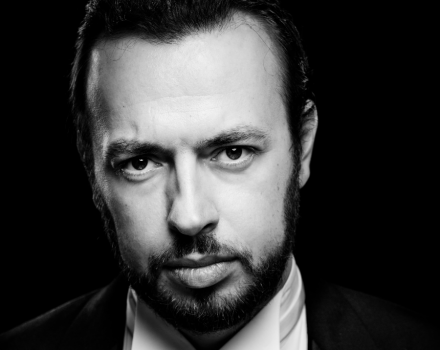

Love, lust and political intrigue fill the world of a passionate singer. When her lover is imprisoned by a police chief, Tosca takes matters into her own hands with dramatic consequences.
Since it premiered in 1900, Puccini’s Tosca remains one of the most frequently performed operas in the world. In Royal Swedish Opera’s concert performance, the tragic destinies of the opera singer and her lover are told through music that is as dramatic and brutal as it is dazzlingly beautiful. The title role is performed by the award-winning Swedish soprano Malin Byström.
Cast
Floria Tosca | Malin Byström |
|---|---|
Mario Cavaradossi | Daniel Johansson |
Baron Scarpia | Łukasz Goliński |
Angelotti | Jeremy Carpenter |
A sacristan | Markus Schwartz |
Spoletta | Niklas Björling Rygert |
Sciaronne | John Erik Eleby |
A jailer | Mattias Milder |
A shepherd boy | Hanna Scheja |
Chorus | Royal Swedish Opera Chorus |
Orchestra | Royal Swedish Orchestra |
| ... | |
Music | Giacomo Puccini |
|---|---|
Conductor | Matteo Beltrami |
Text | Giuseppe Giacosa and Luigi Illica after Victorien Sardou’s play ‘La Tosca’ |
Chorus Master | James Grossmith, Martin Virin (assistant) |
Concert Master | Jannika Gustafsson |
Children’s chorus | Pupils from Adolf Fredrik’s Music School |
Children’s chorus master | Karin Bjurvall |
Assistant Director | Staffan Jennehov |
Sound | Lars-Göran Ehn |
Light | Martin Säfström |
Presenter | Katarina Aronsson (Head of dramaturgy) |
| ... | |
Video
The story
Act 1
Cesare Angelotti, an escaped political prisoner, rushes into the church of Sant’ Andrea della Valle to hide in the Attavanti chapel. As he vanishes, an old Sacristan shuffles in, praying at the sound of the Angelus. Mario Cavaradossi enters to work on his portrait of Mary Magdalene – inspired by the Marchesa Attavanti (Angelotti’s sister). Mario contrasts the beauty of the marchesa with that of the woman he loves, the singer Floria Tosca. The Sacristan mumbles disapprovingly and leaves. Angelotti ventures out and is recognized by his friend and fellow liberal Mario, who gives him food and hurries him back into the chapel as Tosca is heard calling outside. Forever suspicious, she jealously questions Mario, then prays, and reminds him of their rendez-vous that evening at his villa after her performance. Recognising the marchesa’s likeness in the painting, she explodes with renewed suspicions, but he reassures her. When she has gone, Mario summons Angelotti from the chapel; a cannon signals that the police have discovered the escape, so the two flee to Mario’s villa. Meanwhile, the Sacristan returns with choirboys who are to sing in a Te Deum. Their excitement is silenced by the entrance of Baron Scarpia, chief of the police, in search of Angelotti. When Tosca comes back to her lover, Scarpia shows her a fan with the Attavanti crest, which he has just found. Thinking Mario faithless, Tosca tearfully vows vengeance and leaves. Scarpia has the diva trailed scheming to get her in his power.
Act 2
In the Farnese Palace, Scarpia anticipates the pleasure of bending Tosca to his will. The spy Spoletta arrives, not having found Angelotti; to placate the baron he brings in Mario, who is interrogated while Tosca is heard singing a cantata at a royal gala on the other side of the courtyard. She enters just as her lover is being taken to an adjoining room: his silence is to be broken under torture. Unnerved by Scarpia’s questioning and the sound of Mario’s screams, she reveals Angelotti’s hiding place. Mario is carried in; realising what has happened, he turns on Tosca, but the officer Sciarrone rushes in to announce that Napoleon has won the Battle of Marengo, a defeat for Scarpia’s side. Mario shouts his defiance of tyranny (‘Vittoria!’) and is dragged to prison. Scarpia, resuming his supper, suggests that Tosca yield herself to him in exchange for her lover’s life. Fighting off his embraces, she protests her fate to God, having dedicated her life to art and love. Scarpia insists, but Spoletta interrupts: faced with capture, Angelotti has killed himself. Tosca, forced to give in or lose her lover, agrees to Scarpia’s proposition. The baron pretends to order a mock execution for the prisoner, after which he is to be freed; Spoletta leaves. Scarpia prepares a safe-conduct for the lovers. When he embraces her, Tosca, stabs him with a knife from the table, wrenches the document from his fingers and slips from the room.
Act 3
The voice of a shepherd boy is heard as church bells toll the dawn. Mario is led to the roof of Castel Sant’Angelo prison to await execution; he bribes the jailer to convey a farewell note to Tosca. Writing it, overcome with memories of love, he gives way to despair. Suddenly Tosca runs in, filled with the story of her recent adventures. Mario caresses the hands that committed murder for his sake, and the two hail their future. As the firing squad appears, the diva coaches Mario on how to fake his death convincingly; the soldiers fire and depart. Tosca urges Mario to hurry, but when he fails to move, she discovers that Scarpia’s treachery has transcended the grave: the bullets were real. When Spoletta rushes in to arrest Tosca for Scarpia’s murder, she cries to Scarpia to meet her before God, then leaps to her death.
Gallery












